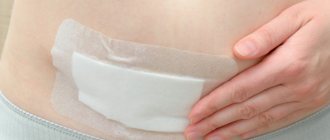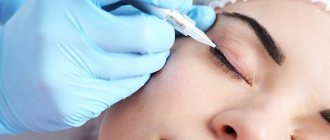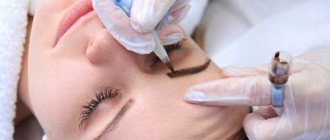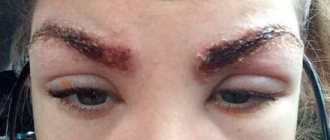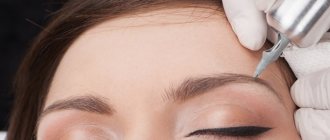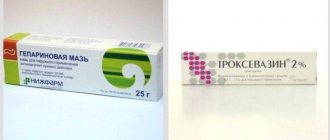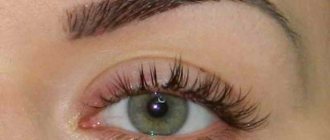Sometimes not every girl has a free minute to put on lipstick. That's why many people resort to permanent lip makeup.
This is a kind of cosmetic tattoo: a specialist uses a needle to introduce pigment granules under the top layer of skin, as a result of which the lips are painted in the desired color, which lasts for a long time.
This is very convenient, because you don’t have to constantly apply lipstick and pencil at work, a party or a wedding.
In addition, lips look expressive and excellent at any time of the day, even at night. But is such a procedure safe?
estet-portal.com sorted out the risks that micropigmentation can bring. 1. Permanent lip makeup: adverse reactions 2. When applying pigment, infection may occur 3. Cosmetic tattoo can cause complications during MRI 4. Lip tattooing may change for the worse 5. Permanent lip makeup may not meet all expectations
History of permanent makeup - created to correct imperfections
Although permanent makeup was popularized in Europe only a few decades ago, the method has deep roots. It was invented in ancient China. Chinese women naturally have very sparse, almost invisible eyelashes and eyebrows; tattoo makeup using natural pigments helped them correct the problem. Bamboo sticks and thin silk fibers served as tools for introducing paints into the skin.
Thousands of years later, at the Cosmetology Congress in New York, this technique was first officially presented by the Chinese woman Cheng Ming. Since then, permanent makeup has gained popularity among women all over the world. At first it was an extremely luxurious and unaffordable procedure - now everyone can afford it.
When applying pigment, infection may occur
of permanent lip makeup does not always end successfully. If such a procedure was performed by an inexperienced specialist in an underground salon, and even using unsterile needles and equipment, there may be a risk of infection in the body.
After all, the nasolabial triangle is an area in which there are many blood vessels. Some of them do not have safety valves. And if an infection gets there, it will immediately penetrate the body.
Thus, cases of infection with infectious dermatitis, viral hepatitis B and even AIDS have been observed.
What is permanent makeup?
Permanent makeup is a tattoo. It is called permanent - however, this does not mean that the paint will remain in its original form forever. The first adjustment must be made after three years.
The permanent makeup procedure consists of emphasizing the shape of the eyebrows, lips and eyes by making corresponding lines on the upper and lower eyelids. This does not mean that a woman should subsequently refuse to use mascara, eye shadow or blush. Permanent makeup should provide cosmetic comfort without replacing all cosmetics.
Permanent makeup procedure
The procedure is ideal for correcting thin or irregular eyebrows, very narrow shapeless lips, and expressionless eyes. The task of permanent makeup is to overcome these shortcomings. To achieve an excellent effect, the procedure must be carried out by qualified cosmetologists - liners. It is important that this is not a random person, but a specialist with experience and good taste.
Cosmetological consequences
Medical problems can be eliminated with medications recommended by the doctor. Cosmetic consequences caused by errors in the work of a tattoo artist are more difficult to eliminate.
Need advice from a beauty expert?
Get advice from a beauty expert online. Ask your question right now.
ask a free question
One of these complications is unsuccessful lip drawing. On the eve of the procedure, you should discuss all the details with the specialist. Only after this proceed to the manipulation.
Among the undesirable consequences of tattooing is an unsuccessfully chosen shade of the dye. To avoid problems, experts recommend choosing the tone closest to your natural lip color.
Sometimes clients complain about a blurry, spreading contour line. It is not possible to eliminate the deficiency.
Dryness and flaking of lips is caused by poor quality pigment or improper care after the procedure. The skin does not receive enough moisture, which causes discomfort. Tattooing with such a complication will not last long.
Who is suitable for permanent makeup?
Permanent makeup, like daily makeup, should emphasize or correct certain facial features. It may not be very intense and bright, but it allows you to always have beautiful eyes and lips, even if you can’t apply makeup.
- Permanent makeup will be of great help to women who lead an active lifestyle and play sports.
- It is suitable for those for whom daily makeup has become a burdensome ritual - not everyone likes to spend a lot of time in front of the mirror.
- It is ideal to do permanent makeup for women who have imperfections in the eyebrows and lips, which can be forgotten for several years.
You can also use the services of a cosmetologist if you want to have an attractive appearance in any situation.
Lip tattooing can change for the worse
Many people believe that lip tattooing will always have an unsurpassed look. But it can change, sometimes not for the better.
The fact is that all people are different. For some, the pigment still remains as bright, but for others it fades, giving the lips an unattractive appearance.
What else can happen is that the colors move, resulting in a rather creepy picture. Most likely, the reason for this is the black Indian ink that is used in practice. Since their particle size is very small, their “migration” occurs.
Contraindications
Like any cosmetic procedure, although it is not dangerous in itself, this type of makeup also has contraindications:
- pregnancy;
- inflammation and infections on the face, such as herpes;
- psoriasis;
- cancer;
- diabetes;
- Taking certain medications, such as steroids, that increase wound healing time.
It's also worth noting that doing this type of makeup is quite a painful procedure, so women with a low pain threshold should not take the risk. Moreover, the paint is applied to extremely sensitive areas of the face.
Do not forget about possible side effects: allergies to dyes or lack of dye degradation after a certain period of time.
results
During the analysis, we found that to perform tattoos in all tattoo parlors, uncertified pigments were used, in which a number of impurities and contaminants were found. To perform tattoos, a wide color palette is used, while the chemical composition of the pigments, as a rule, is not indicated. It has been established that colored and black pigments have different compositions. At the same time, soot still predominates in the composition of black dyes, while the ingredients of colored dyes contain a significant amount of impurities, which determines the maximum number of complications [10]. There are isolated studies devoted to the study of the chemical substances that make up tattoo pigments of various colors. Thus, J. Sowden and D. Slater et al. [11, 12] when studying the red pigment using light and electron microscopy in combination with X-ray microanalysis, it was found that this dye includes aluminum, iron, titanium, silicon, calcium, mercury and cadmium, which can cause various complications.
The composition of dyes depending on color is presented in table. 1 [13,
Table 1. Composition of tattoo pigments depending on the color spectrum and possible complications after the tattoo procedure 14].
In addition to the toxic substances that make up the pigments used for tattoos, a number of researchers have discovered compounds that have a pronounced mutagenic and carcinogenic effect (Table 2).
Table 2. Mutagenic and carcinogenic components included in tattoo pigments
During the analysis, it was noted that the most common complication is allergic reactions, expressed in urticaria (3%), contact dermatitis (19.9%), eczema (7%), anaphylactic reaction (0.1%). In addition, there were cases of infection with HIV (3%) and hepatitis (8%). Secondary infection occurred in 15% of cases.
Side effects had a pronounced polymorphism, including purulent-inflammatory, degenerative, necrotic and tumor processes.
How to do permanent makeup
There are several methods for performing permanent makeup. The choice of method depends mainly on the location where the adjustment needs to be made.
- Feather line method. Allows you to emphasize or reconstruct eyebrows. The device with which the cosmetologist performs makeup has a needle system at the tip, which allows you to create lines that look like individual hairs. The end result is surprisingly natural. However, its disadvantage is the relatively short duration of residence of the pigment in the skin, reaching approximately two years.
- Mechanical method. Most often used. It involves introducing dye under the skin using a device called a contour liner, or, in other words, a microliner. The device looks like a pen tip with a needle that makes almost 200 punctures per second.
- Manual method. Used when it is necessary to obtain the most natural effect. The dye is injected using a needle.
Feather line method before and after
Mechanical method before and after
Material and methods
The research was carried out in several directions. At the first stage, as units of analysis, we selected PubMed publications from 1997 to 2022, devoted to complications after tattooing. The analysis categories combined keywords characterizing the occurrence of complications associated with tattooing. The keywords used were words and phrases such as “tattoo”, “tattoo”, “adverse effects”, “complications of tattoo”, “reaction to tattoo”, as well as various diagnoses in combination with the word “tattoo”.
At the same time, we have accumulated a database of patients in the department of laser therapy and other hardware methods of treatment and diagnosis of the Moscow Scientific and Practical Center for Dermatovenereology and Cosmetology with complications after performing the tattoo procedure.
Clinical and laboratory diagnostics included anamnesis, examination, dermatoscopy, allergy tests, bacteriological examination, immunofluorescence tests, enzyme-linked immunosorbent assay, and in some cases a pathomorphological examination of tattoo tissue biopsies was performed. For this purpose, the material was placed in 10% formaldehyde for 24 hours, embedded in paraffin blocks and followed by standard processing, staining of sections with hematoxylin and eosin and Van Gieson. Microphotographs were taken using a Leica DM 100 microscope with a digital camera.
Statistical processing was carried out using methods generally accepted for medical and biological research using the Excel 7.0 (Microsoft, USA) and ARKADA (Dialog-MSU, Russia) software packages.
Stages of the procedure
- Preparation. The first stage of permanent makeup is coordinating the patient’s expectations with the cosmetologist. A pencil is used to mark the desired changes. The cosmetologist offers options for arrows around the eyes, arches for eyebrows or lip shapes. The main thing is that the new shapes and colors are natural. Remember that we are talking about emphasizing the attributes of beauty, and not about intensively changing natural data.
- Applying a tattoo. Before the pigment is introduced into the epidermis, the skin area is treated with a special ointment. The procedure itself is not only quite unpleasant, but also lengthy and can take up to several hours.
- Treatment after tattooing. The puncture sites are disinfected. A cream is then applied to soothe redness and swelling. Soothing ointments are used for several days after the procedure. At this time, crusts form on the changed areas, which should not be touched, as this can damage the makeup.
The final effect will be visible in a week. At the same time, places that will require the first corrections become noticeable. They can be deposited in approximately three weeks.
What does a bad tattoo look like and the reasons for this result?
Errors when performing lip tattoos can be critical and correctable. The first appear in the form of scars in the mouth area left by a tattoo machine. The lack of professionalism of the master leads to this result. Other consequences can be corrected.
When the result does not meet the client's expectations, it is often positioned as an unsuccessful lip tattoo. These include poorly chosen colors, an unclear or crooked outline, an asymmetrical pattern or significantly reduced or increased volume of the mouth, lines that go far beyond the natural contour, uneven distribution of pigment, and a bluish tint. If you don't get a lip tattoo, there will be no result at all.
Swelling, bruising, allergic reactions are serious consequences of the procedure.
Failure by the technician to comply with sterile conditions may result in infection. If lip tattooing is performed in the presence of contraindications, there is a risk of deterioration in general health.
The following lead to consequences and poor quality results:
- violation of the rules of procedure;
- unprofessionalism of the master;
- the use of cheap tools and low quality pigment.
Indications and contraindications for lip tattooing
Long-term lip makeup is carried out at the request of the client according to her aesthetic preferences. The most common indications are:
- age-related changes in the lip border;
- drooping corners of the mouth;
- pallor of the surface;
- insufficient volume;
- camouflage scars;
- the desire to simplify daily care and maintain the beauty of the lips.
There are situations in which tattooing is contraindicated:
- pregnancy and lactation;
- oncological diseases;
- psychical deviations;
- intolerance to the components of the composition for micropigmentation;
- skin disorders of any etiology (psoriasis, herpes, dermatitis and others).
Reasons for refusing to perform the procedure may include serious pathologies of internal organs, critical days, or acute respiratory infections. In addition, tattooing should not be performed on patients with blood clotting disorders and bronchial asthma.
How does the procedure work?
Permanent makeup is a minimally invasive injection procedure that damages the skin. In this regard, after manipulation, a decrease in general immunity and the addition of a herpes virus infection are possible. In order to prevent the situation, it is recommended to start taking antiviral drugs a few days before the procedure. The tattooing process lasts from 1.5 to 2.5 hours, which depends on the chosen technology, and consists of several successive stages:
- Consultation with a specialist.
- Preparation for manipulation.
- Creating a sketch.
- Anesthesia.
- Disinfection.
- Tattoo.
- Repeated treatment with antiseptic.
The doctor will take a medical history, rule out contraindications, listen to your preferences, and help you decide on the technique and color scheme.
The affected area is cleaned of decorative cosmetics and dust particles using a suitable lotion and tonic.
A “draft” version of the design is applied to the skin. At this stage, the patient can make her own adjustments.
It is carried out using drugs (creams, gels, sprays) containing anesthetics. The product is applied to the desired area and covered with a film for 20 - 45 minutes. After the anesthesia has taken effect, the remaining cream is removed with a swab.
Antiseptic treatment of the surface of the lips is necessary to prevent infection. It is carried out with disinfectants: Chlorhexidine, Miramistin and others.
The master makes microscopic punctures (using special equipment with a sterile disposable needle) strictly according to the intended sketch and using a pre-selected technique.
Application of a regenerating agent and provision of recommendations for further care.
How to avoid herpes after tattooing
If a woman’s skin is prone to the appearance of herpes, it can become a negative consequence of tattooing. To make it go away faster, you need to smear it with healing ointments, such as Acyclovir.
If you want to play it safe before the procedure to avoid herpes, take a course of pills for it. At the pharmacy you can find out the name of the drug that is suitable.
Rashes such as herpes occur not through the fault of the specialist, but due to the predisposition of the client’s skin.
